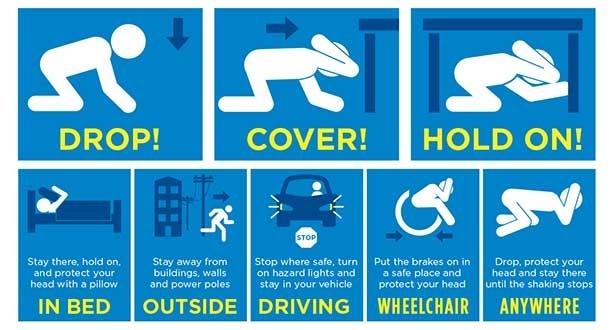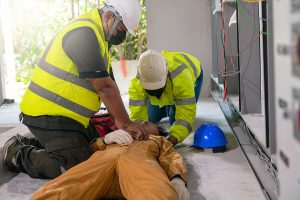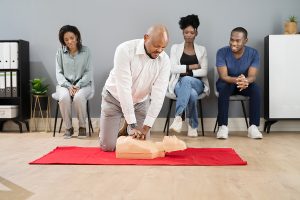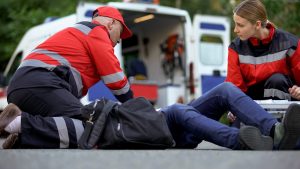If you feel a rumble in the ground, the walls start to shake, and you realize an earthquake is starting, do you know what to do? During an earthquake, inaction might put you at greater risk for injury. Taking a little bit of time now to familiarize yourself with these important safety tips can help you stay safe should you find yourself in an emergency situation.
The good news is that you can learn more about earthquake safety with just three simple words: drop, cover, and hold on. When an earthquake strikes, keep these steps in mind to act quickly and help reduce the risk of injury.
The Importance of Drop, Cover, and Hold On
An earthquake can occur at any time and they often start without warning. Did you know that southern California has about 10,000 earthquakes each year? The majority of them are minor and cannot be felt, but a handful are strong enough to cause serious destruction. Even small earthquakes can cause large complications if you aren’t adequately prepared.
It is important to know how to drop, cover, and hold on during an earthquake. By memorizing these steps, you will be better prepared and can help reduce the likelihood of injury to yourself and your others in your vicinity.
The Basic Principles of Drop, Cover, and Hold On
So, what is drop, cover and hold on? We’ve created this detailed, step-by-step guide to help you learn how to properly drop, cover and hold. You can read up on each step below:
-
Drop
As soon as you notice the first signs of an earthquake, drop onto your hands and knees. Earthquakes are very powerful and might knock you down if you remain standing, which could cause injury. By dropping to the floor and staying low, you will be in a more stable, safe position. From a dropped position, you can also crawl to cover. If you are seated and cannot drop to the floor, you should still follow steps 2 and 3: cover and hold on.
-
Cover
Even small items in your home, such as a vase on a bookshelf or a framed photo on the wall, could cause severe injury if they fall onto you during an earthquake. To protect yourself, you must follow step 2, take cover. First, cover your head and neck with one arm while you seek out a more protective shelter. If there is a sturdy desk or table nearby, you can crawl underneath for cover. If no such furniture is accessible, crawl next to an interior wall and get as far away from windows as possible. Regardless of your location, remain dropped on your knees and bend over to protect your head and vital organs.
-
Hold On
After the initial jolt, there is still a chance of aftershocks, building damage, and other dangers. Because of this, it is important to hold on until you are no longer in immediate danger. Until the shaking stops, stay in your covered, dropped position. Furniture might shift around during the earthquake, so if the table or desk you are under moves, you need to be prepared to move with it. So, you should hold on to your shelter with one hand in order to stay close to it. If you aren’t sheltered under furniture, use both arms and hands to hold on to your head and neck.
What To Do In Other Situations
The random nature of earthquakes means that one very well could strike while you are away from home. Here’s what to do in a variety of specific situations:
- In bed: Stay in bed and lie down. Hold on to your head and neck with both hands. You can cover your head and neck with a pillow for additional protection.
- Outdoors: If you can safely do so, head to an open, clear area free of hazards like trees, street signs, buildings, and vehicles. Be mindful that objects might still fall from the side, so follow the drop, cover, and hold on rules to protect yourself.
- Driving: Stay inside your vehicle. When it is safe to do so, pull over to the side of the road, come to a complete stop, and activate the parking brake. Try to avoid overpasses, bridges, power lines, and other potential dangers. When you resume driving, be sure to avoid damaged areas of the highway or road, and stay clear of emergency service vehicles.
- In a store: You can follow the same general drop, cover, and hold on principles as you would in your home. Use what is around you for cover, such as a shopping cart or clothing racks.
- Near the shore: If you are near a body of water or the coast, you’ll still want to follow the drop, cover, and hold on procedure. Then, when shaking reduces, move inward or to higher ground in case of a tsunami. If possible, walk to avoid traffic slowdowns.
More Tips to Keep In Mind
As soon as the ground stops shaking, assess your situation. If possible, move to higher ground or a safer location. Take a moment to check around you for any new hazards that may have formed, such as leaking gas lines, building damage or collapse, or broken water or electric lines. If there are any injuries to yourself or those around you, use your first aid training to provide assistance.
Prepare For Earthquakes and More With SureFire CPR
Want to learn more about earthquake safety and other emergency preparedness? Reach out to our team here at SureFire CPR. We want to help you feel prepared and answer any questions you have.
If you want to take your safety training up a notch, our certification courses and safety classes––including Basic First Aid and CPR Training––are a great way to boost your knowledge and learn potentially life-saving skills. Contact us by phone at (888) 277-3143 or through our online contact form today!







